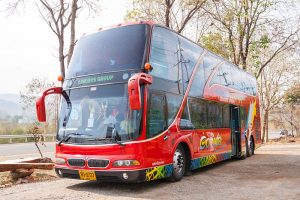 No two car crashes or highway collisions are the same, and no matter how many victims you help recover compensation through the civil courts, you can never be truly prepared for the carnage and tragedy of a crash like the one that happened this week on Interstate 10. There, a tour bus returning from a casino slammed into the back of a slow-moving tractor-trailer truck. The truck was believed to have been traveling at five miles per hour because of utility work that was going on; the bus is believed to have been traveling over 60 miles per hour when it struck the trailer. The crash killed 13 individuals and injured another 31, making it one of the deadliest car crashes in state history.
No two car crashes or highway collisions are the same, and no matter how many victims you help recover compensation through the civil courts, you can never be truly prepared for the carnage and tragedy of a crash like the one that happened this week on Interstate 10. There, a tour bus returning from a casino slammed into the back of a slow-moving tractor-trailer truck. The truck was believed to have been traveling at five miles per hour because of utility work that was going on; the bus is believed to have been traveling over 60 miles per hour when it struck the trailer. The crash killed 13 individuals and injured another 31, making it one of the deadliest car crashes in state history.
“No Evidence the Driver Applied the Brakes”
According to a Fox News report, the California Highway Patrol concluded that there was no evidence the driver of the tour bus applied the brakes to the bus before striking the tractor-trailer. In order to make this conclusion in this or any other car crash case, investigators usually look at two pieces of evidence:
- Skid marks: Skid marks on the roadway near the scene of the crash are a telltale sign that a vehicle attempted to stop prior to the crash. Investigators at the scene of the crash can usually patch skid marks to the vehicle at that made them and, from there, estimate the speed of the vehicle that produced the skid marks. Note, though, the skid marks are typically only produced where the driver slams on his or brakes or attempts to brake suddenly. The presence or absence of skid marks does not always indicate whether the car was traveling at a constant speed, accelerating, or decelerating at the time of impact. Skid marks can only suggest that the vehicle’s driver observed a hazard and attempted to avoid it.
- The vehicle’s black box: In recent times, passenger vehicles and commercial vehicles alike are equipped with “black boxes” – computerized recorders that store important information about the vehicle’s travel prior to a crash. This information can reveal not only the vehicle’s speed immediately before impact but also whether the driver applied his or her brakes. If one is not careful, however, the information from this “black box” can be lost. Specialized equipment is usually needed to retrieve and interpret the information contained in the black box.
More investigation will be performed in this tragic accident to attempt to answer the most pressing question: Why did the bus driver fail to stop, or even slow down, before striking the truck? Answering this question is part of determining the people and/or entities responsible for the crash so that the victims may be able to file personal injury lawsuits and seek compensation from those who are believed to be at fault for causing or contributing to the crash.
See Related Blog Posts
Dramatic Scene as Car Crashes Into Home, Leaving Woman in Critical Condition
(image courtesy of Ilya Plekhanov)
 San Francisco Injury Lawyer Blog
San Francisco Injury Lawyer Blog

